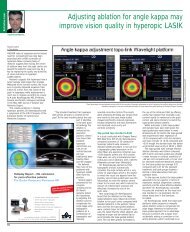ESCRS Guidelines on prevention, investigation and management of
ESCRS Guidelines on prevention, investigation and management of
ESCRS Guidelines on prevention, investigation and management of
Create successful ePaper yourself
Turn your PDF publications into a flip-book with our unique Google optimized e-Paper software.
abbits but the final dose to use, that is also n<strong>on</strong>-toxic, has not yet been established [19], [205].<br />
Clindamycin, vancomycin or cefuroxime are effective for Propi<strong>on</strong>ibacterium acnes endophthalmitis [47],<br />
[140]. However, this must <strong>of</strong>ten be preceded by surgery [66], combined with intravitreal antibiotic injecti<strong>on</strong><br />
[50], [62].<br />
For fungal infecti<strong>on</strong>, amphotericin should be used systemically if it has been given by the intravitreal route.<br />
It is relatively toxic, but quite safe with experience, <strong>and</strong> the help <strong>of</strong> an infectious disease specialist should<br />
be found. In additi<strong>on</strong>, systemic imidazoles are <strong>of</strong>ten given but are more likely to be effective for systemic<br />
infecti<strong>on</strong> than for the endophthalmitis. Voric<strong>on</strong>azole or fluc<strong>on</strong>azole (for C<strong>and</strong>ida albicans) or itrac<strong>on</strong>azole (for<br />
other C<strong>and</strong>ida species, Aspergillus or Cryptococcus) can be given but are not usually as effective as<br />
amphotericin [113], [205], [210]. 5-fluorocytosine can be used in combinati<strong>on</strong> therapy for C<strong>and</strong>ida<br />
albicans. Fusarium endophthalmitis is particularly difficult to treat requiring both surgical removal where<br />
possible <strong>and</strong> chemotherapy (intravitreal, AC instillati<strong>on</strong> or wash-outs, topical <strong>and</strong> systemic routes); Fusarium<br />
is usually but not always sensitive to amphotericin <strong>and</strong> combinati<strong>on</strong> therapy is <strong>of</strong>ten given with imidazoles<br />
[205].<br />
5.3 Anti-inflammatory therapy<br />
Effective anti-inflammatory therapy, e.g. with corticosteroids, is rati<strong>on</strong>al in order a) to limit tissue destructi<strong>on</strong><br />
by infiltrating leukocytes, b) to stem the effect <strong>of</strong> antigens <strong>and</strong> highly inflammatory cell walls released by<br />
bacterial disintegrati<strong>on</strong> after administrati<strong>on</strong> <strong>of</strong> antibiotics <strong>and</strong> c) to diminish the toxic effects <strong>of</strong> intraocular<br />
cytokines. Intravitreal dexamethas<strong>on</strong>e injecti<strong>on</strong> (400 µg in 0.1ml) at the end <strong>of</strong> the vitrectomy leads under<br />
antimicrobial therapy to a more rapid subsidence <strong>of</strong> the intraocular inflammati<strong>on</strong> [65], but without<br />
improving the l<strong>on</strong>g-term functi<strong>on</strong>al outcome although this finding may reflect studies in which<br />
dexamethas<strong>on</strong>e or corticosteroid has been given later rather than initially with the first injecti<strong>on</strong> <strong>of</strong><br />
antibiotics.<br />
Oral administrati<strong>on</strong> <strong>of</strong> prednisol<strong>on</strong>e (1mg/kg body weight) <strong>on</strong>e day after intravitreal antibiotic therapy with or<br />
without vitrectomy has not shown any negative effect <strong>on</strong> the course <strong>of</strong> infecti<strong>on</strong> in bacterial endophthalmitis<br />
[15]. There have also been case reports <strong>of</strong> systemic steroid administrati<strong>on</strong> with mycotic infecti<strong>on</strong>s, likewise<br />
without adverse effects [173]. 200mg prednisol<strong>on</strong>e is <strong>of</strong>ten rati<strong>on</strong>ally given systemically in parallel with<br />
intra-venous antibiotics; however, there are no published studies <strong>on</strong> this subject.<br />
From reports <strong>of</strong> recent experience from others, there seems to be quite a widespread use <strong>of</strong> a trial <strong>of</strong><br />
corticosteroid drops in post-operative inflammati<strong>on</strong>. Our view is that in uncomplicated phacoemulsificati<strong>on</strong><br />
surgery with significant post-operative inflammati<strong>on</strong> the patients should have an immediate vitreous biopsy<br />
<strong>and</strong> intravitreal antibiotics with no delay, <strong>and</strong> a trial <strong>of</strong> corticosteroid drops should not be performed.<br />
To summarise, not <strong>on</strong>ly the microbes but also their interplay with the immune mechanisms, are important in<br />
the outcome <strong>of</strong> endophthalmitis. Cell walls <strong>of</strong> dead bacteria, especially those <strong>of</strong> streptococci, <strong>and</strong> including<br />
those recently killed by antibiotics, are highly inflammatory. As a direct c<strong>on</strong>sequence, anti-inflammatory<br />
treatment with intravitreal dexamethas<strong>on</strong>e (400 µg in 0.1ml) should be given al<strong>on</strong>g with specific intravitreal<br />
anti-microbial therapy. In additi<strong>on</strong>, surgical removal <strong>of</strong> a high bacterial load in the vitreous can also be<br />
important to save visi<strong>on</strong>, by removing the main source <strong>of</strong> the acute inflammatory effect.<br />
5.4 Other types <strong>of</strong> post-operative endophthalmitis<br />
Late cases <strong>of</strong> endophthalmitis after cataract operati<strong>on</strong> are the sec<strong>on</strong>d comm<strong>on</strong>est form <strong>of</strong> endophthalmitis<br />
accounting for 20 to 30 per cent in past studies following ECCE surgery; the symptoms are milder <strong>and</strong><br />
Propi<strong>on</strong>ibacterium acnes has been identified as the principal pathogen. There is difficulty in culturing it as<br />
the bacterium is <strong>of</strong>ten enclosed in the synechised capsular sac. The high rate <strong>of</strong> recurrence is problematic,<br />
which can <strong>on</strong>ly be reduced by vitrectomy, possibly combined with posterior capsulectomy [160]. A further<br />
advantage <strong>of</strong> vitrectomy is that adequate material for culturing the causative organism can be obtained but<br />
capsular bag material is needed as well (refer to Flow Chart 3.3). Early vitrectomy is advisable [111]. A trial<br />
<strong>of</strong> therapy should be given with clarithromycin 250mg twice daily (refer to Flow Chart 5.7, [115]) which can<br />
be effective without surgery because the drug is well absorbed <strong>and</strong> c<strong>on</strong>centrated 200 times into<br />
macrophages <strong>and</strong> other cells.<br />
25





